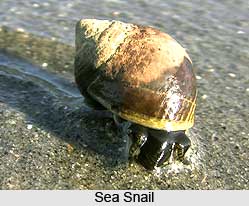 Sea Snails are of different kinds and they vary widely in shape, habits and other details. There are the Top and Turban Shells, Periwinkles and Violet snails. Top shells and Turban shells are familiar univalve molluscs of all seashores, living on mud-covered rocks of the intertidal region. In their internal structural details they agree with the primitive gastropods like Limpets. They possess a radula, carrying numerous tiny teeth for grinding sea plants. Their shells are fairly heavy, usually brightly coloured, ornamented outside and pearly within. Species like Trochus radiatus and Clanculus depictus have conically spiral shells carrying rows of small smooth tubercles over the whorls and coloured designs of red and greyish blue. They have a flat base and their shell-lids are thin and made of lime. Turbo is a large turban-shaped shell with rounded whorls, brownish or greenish in colour, rounded at the base and having a circular, thick, hemispherical operculum. The shells of Turbo have commercial value for the mother-of-pearl contained in them.
Sea Snails are of different kinds and they vary widely in shape, habits and other details. There are the Top and Turban Shells, Periwinkles and Violet snails. Top shells and Turban shells are familiar univalve molluscs of all seashores, living on mud-covered rocks of the intertidal region. In their internal structural details they agree with the primitive gastropods like Limpets. They possess a radula, carrying numerous tiny teeth for grinding sea plants. Their shells are fairly heavy, usually brightly coloured, ornamented outside and pearly within. Species like Trochus radiatus and Clanculus depictus have conically spiral shells carrying rows of small smooth tubercles over the whorls and coloured designs of red and greyish blue. They have a flat base and their shell-lids are thin and made of lime. Turbo is a large turban-shaped shell with rounded whorls, brownish or greenish in colour, rounded at the base and having a circular, thick, hemispherical operculum. The shells of Turbo have commercial value for the mother-of-pearl contained in them.
Closely allied to Top snails is an extremely curious species of snails called Umbonium vestiarum which occurs in plenty in all littoral mud-flats. Their shells are small, smooth, polished, flattened cones resembling coat buttons, whence their popular name Button shells. They are coloured differently - white, red, pink, chestnut, deep orange or any one of these colours mottled or streaked with a contrasting colour. They are beautiful objects, widely collected and exported to foreign countries for studding jewel boxes.
Periwinkles are represented abundantly on all the rocky shores of India by the genus Littorina and the allied Planaxis. They are a group of interesting sea snails. They can be seen slowly moving about on high coastal rocks and branches of mangrove trees feeding on tiny plant growths and algae. Their proboscis is short but the radula very long, well suited for chafing the vegetative food. Their shells are like pointed turbans, drab-coloured and quite in harmony with their environment - brown algae, greyish black rocks or dark brown branches of mangroves. The periwinkles living high up on rocks receive only a few sprays of water from high-tide waves but they do not suffer because they possess a rudimentary lung which enables them to breathe air and remain out of water for several hours. Periwinkles deposit their spawn on seaweed, rocks and stones. The eggs are enclosed in a glairy mass which is just able to retain its shape in the water - each egg has its own globe of jelly and is separated from the others by a very thin transparent membrane.
Then there are the Violet snails of the genus Janthina, which float on the surface of the sea in an inverted position with the help of a frothy, small boat-shaped float secreted by the foot. The female snail attaches her eggs to the underside of the float. The colour scheme of the shell has a protective significance. Birds cannot easily see it as the deep purple colour of the base of its shell harmonizes with the colour of the deep blue waters. Similarly, to predatory fishes the light blue spirals of the shell merge with the colour of the sky.
Communities of Violet snails and blue jellyfish (such as Physalis, the Portuguese man-of-war) float together on the surface of the ocean, the snails feeding on the jellyfish, and the jellyfish feeding on small fish that get entangled in their stringing tentacles.
Another interesting sea snail of pelagic habit is the Sea Butterfly - Cavolina belonging to the group Pteropoda. It is an extremely interesting mollusc in that its structure and habits amply justify the name `sea butterfly` given to it. Its shell is not coiled but straight and usually elongated and its foot modified into a pair of wing-like fins, arranged one on either side of the mouth, enabling it to swim with ease. These animals spend their whole life in the open sea in such vast swarms as to discolour the water for miles. The feed on plankton - minute floating sea organisms - and they themselves form the principal food of baleen whales.



















